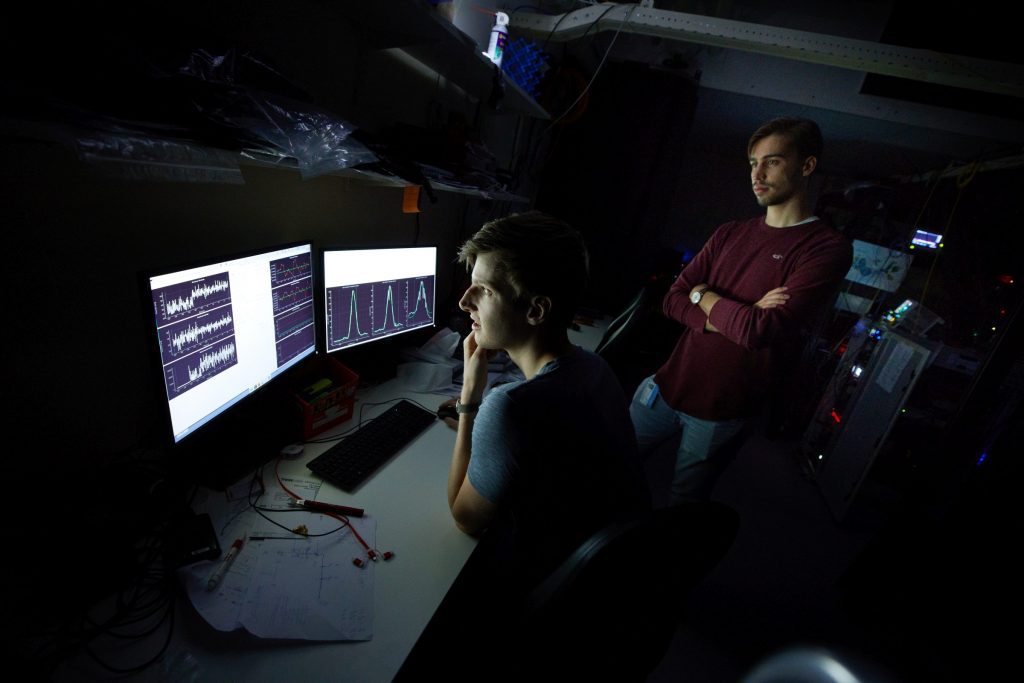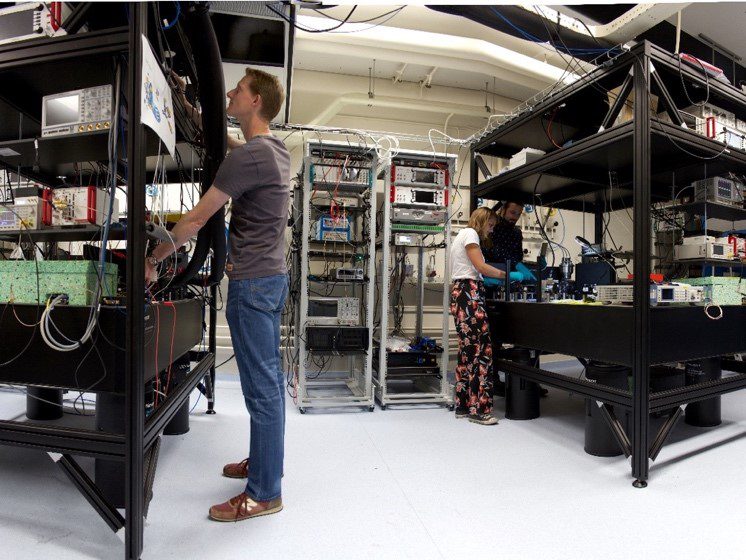22.06.2022Quantum Internet
Linking two independent quantum nodes for future metropolitan quantum networks

Researchers at QuTech have demonstrated a key technology for linking quantum nodes over existing telecom fiber, by realizing quantum interference of photons emitted by quantum devices at telecom wavelengths. The technique also allows for compensating intrinsic differences between the quantum devices. The work is published in PRX Quantum and is an important step for bringing quantum networks out of the lab and into real-world settings.
Quantum networks hold the promise of fundamentally changing the way we share and process information. A future quantum internet, built using quantum processor nodes connected via optical channels, will enable applications ranging from secure communication to cloud computing with full privacy and enhanced sensing.
Entanglement between network nodes
For a quantum network to function it uses a particular quantum effect between the nodes in the network called quantum entanglement. Practically entanglement means that the state of a second qubit (that can be ‘1’ or ‘up’) is dictated by the state of a first qubit (i.e. ‘0’ or ‘down’). This entanglement can be used for generating secret keys for private communication, or teleportation of a quantum state between far away parties. QuTech was the first to establish a multi-node network in the lab [link], by using optically active spins in solids.
Entanglement between network nodes is generated by first entangling the spins with flying photonic qubits and then interfering those photons in a connecting middle station. For scaling this approach to larger networks two major challenges arise. “Leading platforms for a future quantum network emit photons in the visible spectrum and fiber losses at these frequencies hinder scaling beyond a few kilometers”, says first author Arian Stolk. “So, to bring these quantum networks out of the lab and to move towards metropolitan scale, it is crucial to convert the frequencies of the photons to the telecom band, whilst maintaining their quantum feature. Moreover, overcoming the intrinsic variations between our quantum chips and ensuring compatibility with other nodes is a challenge for scaling up. In this paper, we introduce a method that tackles both these challenges simultaneously.”

Solving fiber loss and variations between chips
The approach used to tackle the challenges is based on a technique called ‘quantum frequency conversion’. It uses a strong pump laser that interacts with the single photons inside a specially designed crystal, subtracting energy in the process. The exact frequency that the single photons end up with can be controlled by adjusting the pump laser frequency, giving the researcher the ability to precisely match different nodes over a network.
From visible wavelengths in the lab to telecom bands
The researchers at QuTech—a collaboration between TNO and TU Delft—demonstrate their technique by building two remote quantum nodes based on the nitrogen-vacancy (NV) center in diamond. “We show that the resonant emission of the NV centers (around 637nm) can be faithfully converted very precisely to a wavelength in the telecom L-band (1588nm) by locking to a central reference laser, over a broad range of frequencies. This technique facilitates scaling by removing the difference in emission frequency between nodes that existed before the conversion.”
The way the researchers verified their scheme is through an interference experiment. It is done by sending single photons from the remote nodes through their respective converters, towards a beam splitter, after which they are detected. For the photons that were expected to be indistinguishable from each other, a reduction in simultaneous clicks in the detectors was observed, in line with the theory describing the process. “Further analysis finds a high degree of indistinguishability of the converted photons, emphasizing the effectiveness of our scheme”, says Stolk.
Towards 20 km deployment
Looking forward, the presented results are an important milestone towards achieving entanglement of NV center nodes over tens of kilometers of deployed telecom fibers. Great effort has already been taken to prepare the nodes for operation over such a long-range connection. Entanglement between solid state quantum processors over such distance would constitute a proof of principle for future entanglement-based quantum networks on a metropolitan/national scale. “We also believe that other quantum platforms in diamond, silicon, and silicon carbide that emit in the visible spectrum, can benefit from our technique.”
Funding details
We acknowledge funding from the Dutch Research Council (NWO) through the project “QuTech Part II Applied-oriented research”(Project No. 601.QT.001), a Vici grant (Project No. 680-47-624), and the Zwaartekracht program Quantum Software Consortium (Project No. 024.003.037/3368). We further acknowledge funds from the Dutch Ministry of Economic Affairs and Climate Policy (EZK), as part of the Quantum Delta NL program, and Holland High Tech through the TKI HTSM (20.0052 PPS) funds.
Publication details
Telecom-Band Quantum Interference of Frequency-Converted Photons from Remote Detuned NV Centers
A.J. Stolk, K.L. van der Enden, M.-C. Roehsner, A. Teepe, S.O.F. Faes, C.E. Bradley, S. Cadot, J. van Rantwijk, I. te Raa, R.A.J. Hagen, A.L. Verlaan, J.J.B. Biemond, A. Khorev, R. Vollmer, M. Markham, A.M. Edmonds, J.P.J. Morits, T.H.T. Taminiau, E.J. van Zwet, and R. Hanson. PRXQuantum, 2022, DOI: 10.1103/PRXQuantum.3.020359

